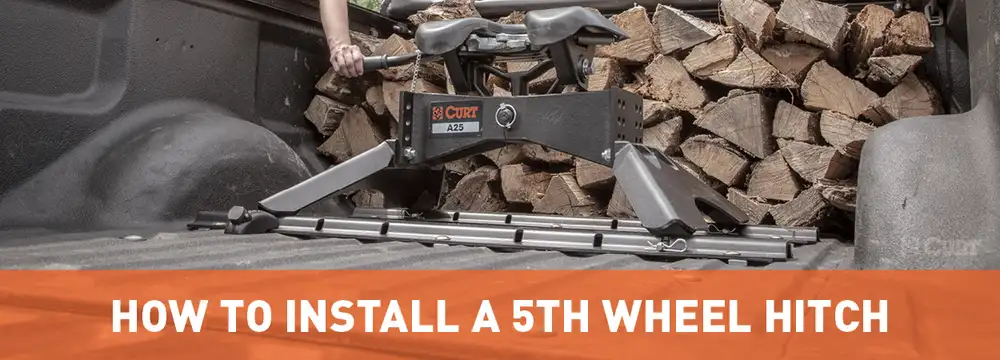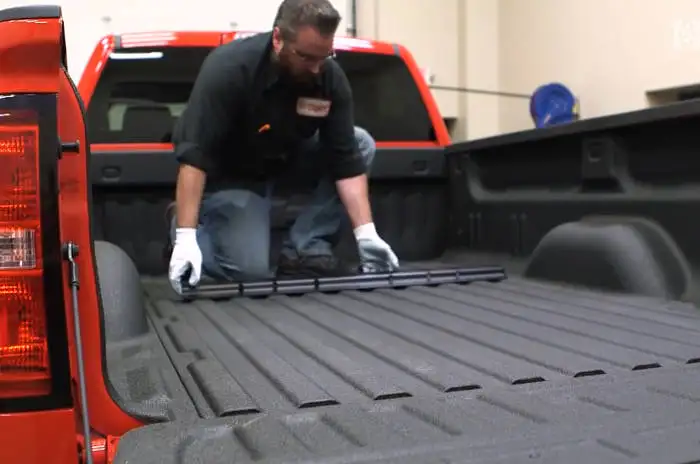How to Install a 5th Wheel Hitch


5th Wheel Hitch Installation How-To
15 Steps to Install Brackets, Rails and the Hitch
How do you install a 5th wheel hitch? Installing a 5th wheel hitch involves removing the spare tire, measuring where bolt holes need to be drilled, drilling into the truck bed, assembling the 5th wheel hitch, measuring the trailer height, installing bolts and torqueing hardware.
In the following guide, we will go step-by-step through the process of 5th wheel hitch installation. Remember to follow the specific instructions for assembly when mounting your own 5th wheel hitch.
- Remove the spare tire
- Position the front base rail
- Mark the first drill location and drill a pilot hole
- Check the pilot hole under the truck bed and drill the remaining holes
- Enlarge the bolt holes
- Bolt in the under-bed brackets
- Bolt down the front 5th wheel rail
- Measure the 5th wheel hitch height
- Attach the 5th wheel legs
- Position the rear 5th wheel rail
- Drill holes for the rear base rail
- Bolt down the rear base rail
- Install any remaining bolts
- Torque all hardware
- Secure the 5th wheel hitch
How to install 5th wheel rails video
How to install a 5th wheel hitch video
Step by Step 5th Wheel Installation
Step 1: Remove the spare tire
Installing a 5th wheel with brackets and base rails requires access to the underbelly of your truck bed. Remove the spare tire to give yourself more space.
You may also need to remove a heat shield or other components throughout the process. Be sure to follow the instructions accompanying your specific hitch.


Step 2: Position the front base rail
Place the base rail that will be closest to the truck cab into position, measuring the correct distance from the front of the truck bed. This distance can vary between long-bed and short-bed pickup trucks. Refer to the instructions for exact measurements.
You will also need to center the base rail between the wheel wells.


Step 3: Mark the first drill locations
With the base rail correctly positioned, mark the bolt hole locations for the rail, using a paint pen.
Then, use a center punch to mark just one of the drill locations. The other bolt locations will be marked in a later step. The center-punch will pinpoint exactly where to drill and will help keep the drill bit from wandering. Finally, drill a pilot hole down through the marked location.


Step 4: Check the pilot hole under the bed
Temporarily position the appropriate under-bed 5th wheel bracket, corresponding to the pilot hole location you just drilled.
If the bracket lines up correctly with the hole, the remaining bolt holes can be drilled. Mark them with a paint pen, move the base rail out of the way, center-punch the drill locations and drill down from above the truck bed.


Step 5: Enlarge the bolt holes
Using a step bit, drill out the pilot holes until they are large enough to accept the bolts of the 5th wheel rails. Go slowly and drill carefully.
With the bolts holes drilled to the proper size, we recommend using some touch-up paint to protect any exposed metal edges. This will help prevent corrosion. Deburr the drilled holes, and then apply the paint.


Step 6: Bolt in the under-bed brackets
Position the under-bed brackets on either side of the truck bed. These are typically installed from the wheel well opening.
Place the appropriate bracket or brackets into position and fasten them to the frame of the truck with the included nuts and bolts. Then, fasten the other bracket on the opposite side of the truck.


Step 7: Bolt down the 5th wheel rail
Reposition the base rail again in the truck bed over the appropriate bolt hole locations. If the truck has bed rails in the bottom of the truck bed, spacers may be included. These need to be positioned under the 5th wheel rails, between the truck bed rails, to ensure consistent metal-to-metal contact.
With the rails in position, insert the bolts down through the holes and secure them with nuts applied underneath the truck bed.


Step 8: Measure the 5th wheel hitch height
Your 5th wheel hitch will need to be installed at the correct height to accommodate your truck bed. There must be a minimum height difference of 5-1/2" between your truck bed walls and the trailer.
To find the the hitch height, make sure your trailer is parked on a level surface. Then, measure from the ground to the underside of the kingpin plate (A). Next, measure from the ground to the top of the open tailgate of your truck (B).
A minus B equals C, the required height for your 5th wheel hitch.


Step 9: Attach the 5th wheel legs
With the hitch height measured, find the correct mounting holes on your 5th wheel hitch head to accommodate the necessary height. Most 5th wheel hitches offer a range of vertical adjustment. Position the legs onto the head and secure them in place, using the included bolts.
For some 5th wheels, you may need to remove the head plate to access the leg bolt holes. It may also be helpful to turn the head upside-down to install the legs.
For short-bed trucks, a 5th wheel slider may be needed. Learn how to measure your truck bed.


Step 10: Position the rear 5th wheel rail
With the 5th wheel hitch assembled, you can now easily find the position for the second, rearward base rail.
Have a friend help you lift the 5th wheel hitch into place, installing the legs into the base rail you’ve already installed. Then, position the second base rail, using the leg anchors on the 5th wheel hitch as a guide for the correct location.


Step 11: Drill holes for the rear base rail
Before marking the drill locations for the second base rail, make sure that the rail is centered in the truck bed, between the wheel wells. Then, mark the drill points with a paint pen, move the rail out of the way (and hitch assembly if necessary), center-punch and drill pilot holes.
Next, use a step bit to enlarge the holes to the correct diameter for the base rail bolts. Finish off the bolt holes with touch-up paint to help prevent rust.


Step 12: Bolt down the rear base rail
Reposition the second 5th wheel rail and insert the included bolts down through the holes you just drilled in the truck bed. The bolts will pass through the rail, the truck bed and the under-bed brackets already installed.
As with the first base rail, the nuts to fasten the bolts will need to be installed from underneath the truck bed. Be sure to install any spacers or additional hardware specified in the instructions.


Step 13: Install any remaining bolts
Some 5th wheel installations require supplemental bolts to be installed in both rails, providing enhanced security and strength. Marking the drill locations is not necessary. Simply center-punch, using the rail as a guide. Then, drill pilot holes and enlarge the holes with a step bit.
Finally, insert the necessary bolts and fasten them with nuts underneath the truck bed.


Step 14: Torque all hardware
With the base rails completely installed with all necessary hardware, it is time to fully tighten the bolts. This requires a torque wrench. Torque values vary by bolt size and will be specified in the installation instructions included with your hitch.
5th wheel hardware may require torque greater than a typical 100-foot-pound torque wrench can provide. Instead of purchasing a new torque wrench, call your local automotive store and ask it they rent out tools and equipment.


Step 15: Reinstall the 5th wheel hitch
Lift the 5th wheel hitch assembly back into place, dropping it into the fully installed base rails. If you haven’t torqued the hardware on the hitch yet, do so at this time. Also, make sure that all necessary pins and other components are installed before hitching up to tow.


FAQs
How much does it cost to install a 5th wheel hitch?
A professional 5th wheel hitch installation can cost anywhere from $70 to $225, depending on the hourly labor rate and the components being installed on your truck. If custom brackets and a basic 5th wheel hitch are being installed, costs will tend to be lower. If drilling is required and more complex 5th wheel components are needed, the price may go up. Also note that a dealership may charge more than an independent shop.
To decide if a professional 5th wheel install is within your budget, call a local installer and ask for a quote.
Can I install a fifth wheel hitch?
Yes, most fifth wheel hitches can be installed without professional help as long as you have the tools for the job. Typical tools required include a ratchet, socket set, crescent wrench, drill with drill bits and a torque wrench.
Before deciding to install the fifth wheel hitch by yourself, read through the instructions specific to your brackets, rails and hitch model.
How long does it take to install a fifth wheel hitch?
Installing a fifth wheel hitch can take anywhere from 1 hour to 2.5 hours, depending on your level of expertise. Installing the custom brackets typically takes anywhere from 40 to 90 minutes. Assembling the fifth wheel hitch usually only takes 15 to 30 minutes. If your truck requires a roller or slider, an extra 20 to 40 minutes may be required.
If you are installing a set of puck system legs or an adapter, installation can be completed in just a few minutes if the hitch is already assembled.
- Custom brackets (no drilling) – 40 to 80 minutes
- Semi-custom brackets (drilling may be required) - 90 minutes
- Fifth wheel hitch assembly – 15 to 30 minutes
- Roller / slider assembly – 20 to 40 minutes
Where do you put a fifth wheel hitch?
A fifth wheel hitch is designed to install in a truck bed, centered between the wheel wells and mounted directly above or slightly in front of the rear axle. For exact positioning, the installation instructions will provide measurements and references to walk you through the process.
When not towing a trailer, a fifth wheel hitch can be disassembled and removed from the truck bed base rails to be stored in your garage, shop or shed.
 ARIES
ARIES  CURT
CURT  LUVERNE
LUVERNE  UWS
UWS 



